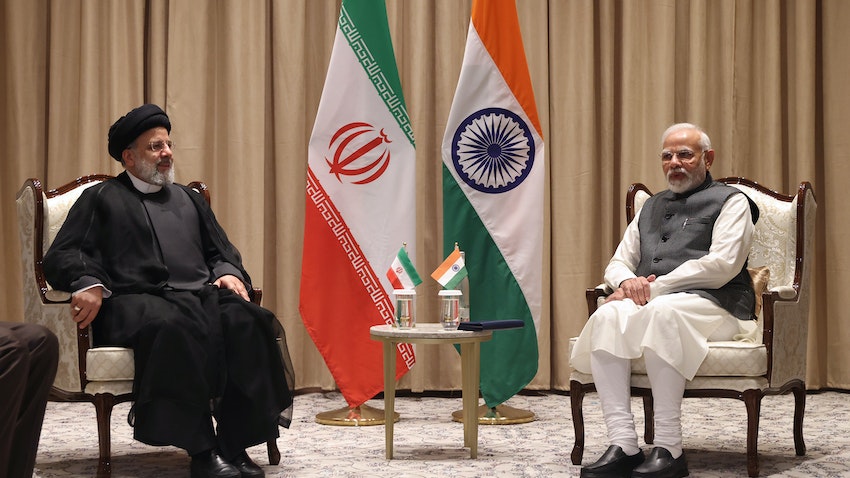Earlier this year, Iranian Foreign Minister Hossein Amir-Abdollahian abruptly canceled his attendance of an annual multilateral meeting in New Delhi.
The controversy highlighted ongoing hurdles in India-Iran relations, as Tehran continues to struggle to achieve the desired progress in bilateral ties. There is no doubt that China has taken center-stage in Iran’s Asia policy. However, the boost in India-Russia trade due to western sanctions on Moscow could highlight Iran’s transit potentials, and thereby reignite Indo-Iranian relations, Hamed Kermani a PhD in international relations, wrote for Amwaj.media. Excerpts of the article follow:
Tehran Looks to the East
Since the 1979 Islamic Revolution and the founding of the Islamic Republic, successive Iranian governments have looked east for allies. The incumbent Ebrahim Raisi administration has also reiterated this outlook. For instance, upon his appointment as chief diplomat in August 2021, Amir-Abdollahian promised a pivot toward “Asia-centered” foreign policy.
This strategy seeks to use partners in Asia to offset economic and diplomatic issues that Iran has faced amid sanctions by — and tensions with — the West. China and Russia have been pivotal to this effort.
India's position in this framework is less secure. Several factors, both bilateral and global, strain the relationship. The latter has prevented ties between New Delhi and Tehran from developing into a more strategic and permanent relationship.
Bilaterally, the obstacles are mostly economic and ideological. Despite recent growth in trade, the exchange balance tilts in India's favor.
Data released by the Indian authorities in February showed that $653 million worth of goods were imported from Iran last year, while exports amounted to $1.84 billion in 2022. These figures indicate that bilateral trade is majorly depressed and show a striking shift away from trade surpluses previously enjoyed by Iran.
The change in trade patterns can largely be pinned down to India’s decision to stop importing oil from Iran in 2018, a sore point for many in Tehran. The Indian move came after the US, under then president Donald Trump (2017-21), unilaterally exited the 2015 Iran nuclear deal and reimposed all sanctions on the Islamic Republic.
Tension over these changes lingers as Iran needs to sell more oil to secure revenues for its beleaguered, sanctions-hit economy.
New Delhi has sought diverse energy sources and has also benefited from various constraints that sellers are under to buy oil at a significant discount, including from Russia. Of note, Moscow last month became India’s largest crude supplier, displacing Iraq which, in turn, had largely taken much of Iran’s lost market share.
In this context, New Delhi’s reluctance to import Iranian petroleum while happily snapping up crude from other suppliers sanctioned by the west is an alarming sign of the state of Indo-Iranian relations.
International Factors
Globally, India’s close relationships with Iran’s main adversaries — Israel and the US — are the most disruptive factors in the relationship. Despite Indian leaders' attempts to portray things as otherwise, Iran’s enmity with two countries that India has close ties with has hampered bilateral relations. For example, US sanctions have not only impacted Iranian oil exports but have also hindered Indo-Iranian cooperation on the development of Iran’s southeastern Chabahar Port. The facility is an integral part of the International North-South Transportation Corridor. At least prior to the Taliban takeover last year, INSTC was also envisioned as an Indian gateway to Afghanistan.
Although the Chabahar project is formally exempt from US sanctions, Indian companies have been reluctant to engage since Washington’s reimposition of economic pressure on Tehran in 2018. Iran has, therefore, continued to develop the port without any significant Indian presence, instead offering opportunities to Chinese companies. New Delhi and Tehran may have politically reaffirmed their commitment to the overall project, but the Indian role in Chabahar will likely remain marginal.
Having said that, the jump in India-Russia commercial exchanges, particularly mindful of progress on a free trade deal, could revitalize focus on Iran’s transit potentials. Of note, Iran’s geography is a key element of INSTC, offering a link between India and Russia.
But Israel presents an added complication. New Delhi has tried to balance its relations with Tehran and the Islamic Republic’s rivals, while Iran has attempted to insulate its links with India from other actors. But the depth and nature of the relationship between New Delhi and Tel Aviv has not gone unnoticed in Tehran.
India attaches a lot of importance to its relations with Israel. Alongside a close personal relationship between Indian Prime Minister Narendra Modi and his Israeli counterpart Benjamin Netanyahu, India receives a large and vital share of its arms from Israel.
Since Modi took office in 2014, India has been the largest destination of Israeli arms exports, receiving around 42% of the total. New Delhi also benefits from Tel Aviv promoting India as a partner in Washington.


